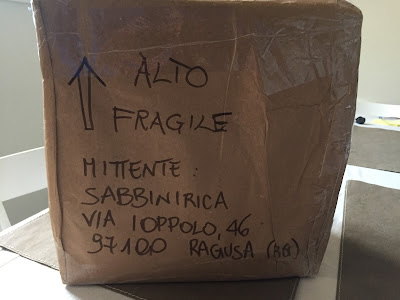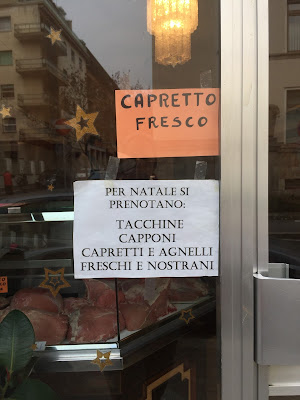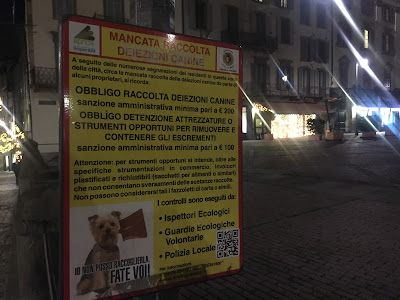

Left: Hiking route from Cattedrale Vegetale to Capanna 2000. Right: Descending from Capanna 2000 in snow and Cima Menna in the background.
Overview
Length: 8 km
Duration: 3:50 hh:mm
Elevation: Lowest point parking just above Plassa @ 1200 m (3739 ft), highest point Rifugio Capanna @ 1969 m (6460 ft)
Location: Italy, Lombardy, Bergamo, Val Brembana, Alpe Arera
Getting There
A car is really the easiest to get to this hike; we went with our friends who have a car. Blanche Dubois said “Whoever you are, I have always depended on the kindness of strangers.”
We researched buses and it looks like it is possible to get from Bergamo to Zambla Alta, but choices are limited. From Zambla Alta you’d have to walk a fair bit up the main road to get to the Cattedrale Vegetale.
The Walk
I've wanted to see the Cattedrale Vegetale ever since I heard about it a year ago. Some hike-minded friends decided to take us to see it (maybe to shut me up) and then continue on to Capanna 2000 for lunch. As it had just snowed a few days earlier (a bit late in the season), we were looking forward to time in the snow and we weren’t disappointed.
Along the way, we stopped for espresso at the Rifugio Ca' d'Arera S.A.B.A or Società Alpinistica Bergamo Alta. As the crow flies, Bergama Alta is only 25 km (16 miles) away, though driving there is about 45 km (28 miles) following the contours of the Val Seriana and Val di Riso. Passing over the Colle di Zambla takes you from Val Seriana to Val Brembana.
Capanna 2000 is at 1969 m, a few meters shy of 2000 m. Capanna translates as shack or cabin, but it’s a nice rifugio to grab a bite to eat. And eat too much we did, but it was good.
The Cattedrale Vegetale is a “land art” or “natural art” project by Giuliano Mauri (1938 – 2009). It consists of 5 naves and 42 columns arranged as you might expect in a cathedral, except this cathedral is open to the world and each column is hollow and made of a mesh of intertwined wood poles and branches. A beech tree is growing in the center of each column. The idea is that after 20 years, the (dead) wooden structure of the columns decays and gives way to the live tree that has grown up to fill in the column. Nature taking over, but keeping the form that man created. Despite some of the problems such as dead or slow growing trees (as reported here in Italian), the idea is cool and we like it. Our hiking mates (locals) thought it was frivolous. There are two other cathedrals by Mauri: one in Lodi and one in Malga Costa.
From the Cattedrale Vegetale to Capanna 2000 was pretty straightforward. You are still on road for a while, which was a little annoying. We were told that the paving was a relatively recent addition. Even after Rifugio Ca' d'Arera S.A.B.A, there are parts of the trail that are paved. The more interesting hiking starts after Capanna 2000 to the top of Arera, but that wasn’t on our radar today.
While walking up to Capanna 2000, we came across old mines and heaps of rocks dug out of the earth. Zinc was extracted in the area between Gorno and Oltre il Colle until it was decided in 1982 to import the mineral instead. The abandoned mines – 250 km worth of tunnels – are now being investigated and expanded by the Australian firm, Energia Minerals, for zinc, lead, and silver. It is predicted that the three largest zinc extraction sites in the world will soon be exhausted and this area in Bergamo will become a gold mine.
Flora
Here are a few of the plants we saw today. For more information about identifying plants, see Resources for Identifying Plants around Bergamo.
[Family] Genus species – {Common names in English; Italian}
[Asteraceae] Petasites hybridus – {Butterbur, Pestilence Wort; Farfaraccio maggiore}
[Boraginaceae] Pulmonaria sp. – { Lungwort; Polmaria}
[Brassicaceae] Cardamine bulbifera – {Coralroot Bittercress; Dentaria minore con bulbilli ascellari}
[Ericaceae] Erica carnea – {Winter Heath; Erica carnicina}
[Fabaceae] Hippocrepis comosa – {Horseshoe Vetch; Sferracavallo commune}
[Gentianaceae] Gentiana clusii – {Clusius’ Gentian; Genziana di Clusius}
[Gentianaceae] Gentiana verna – {Spring Gentian; Genziana primaverile, genzianella di primavera}
[Liliaceae] Scilla bifolia – {Alpine Squill; Scilla silvestre}
[Ranunculaceae] Anemone nemorosa – {European Wood Anemone; Anemone del boschi}
[Pinaceae] Pinus mugo – {Creeping pine, mountain pine; Pino mugo}
[Ranunculaceae] Helleborus viridis – {Green Hellebore; Elleboro verde}
[Rosaceae] Potentilla sp. – {Cinquefoil}
[Caprifoliaceae] Valeriana sp.


Two photos of the column structures of the Cattedrale Vegetale (Oltre Il Colle).


Left: Cattedrale Vegetale (Oltre Il Colle) with Zambla Bassa in the background. Right: View of Cattedrale Vegetale (Oltre Il Colle) with Monte Alben in background.
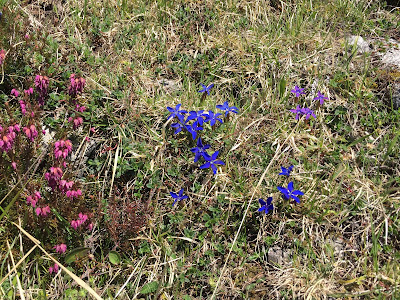
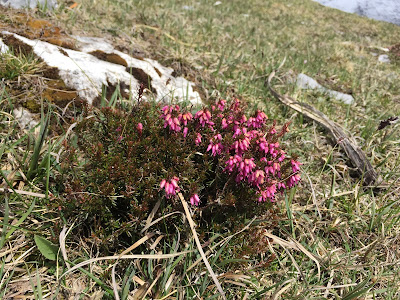

Shots of the pasture below Capanna 2000. Erica carnea and Gentiana and rock pile from mining operations.
![Photo of [Gentianaceae] Gentiana clusii. Photo of [Gentianaceae] Gentiana clusii.](https://blogger.googleusercontent.com/img/b/R29vZ2xl/AVvXsEh4Y7ppo0p8JuSJXaBLNxRD_LeeLC1uH0m9wXWpsbkLb_rctKDMkzu7UN200h9nJBr9x8D3-k8SMFos15yyayzggM0e7H7c5-6f0eoAUL1FY_bwGWcBq2K7V8-jtl5xR-zzg1x7-KzpWQ/s280/Flora+-+Gentiana+clusii+1.jpg)
![Photo of [Gentianaceae] Gentiana clusii. Photo of [Gentianaceae] Gentiana clusii.](https://blogger.googleusercontent.com/img/b/R29vZ2xl/AVvXsEiBwpNr5BJYS26JQbDtBSi8dsEyH6jFW2fvQ7Cmhiqh5y5yi4CJKo00GCwFcPQ22jHk6mTL2AtIP4eqLB5PMFJAi1StC-dVJZ_DtHhq_h6_rGHxTBR8PpVoy_0NkZqjUKbY1S4A6u5Icg/s280/Flora+-+Gentiana+clusii+2.jpg)
Two photos of [Gentianaceae] Gentiana clusii – {Clusius’ Gentian; Genziana di Clusius} below Capanna 2000.
![Photo of [Gentianaceae] Gentiana verna. Photo of [Gentianaceae] Gentiana verna.](https://blogger.googleusercontent.com/img/b/R29vZ2xl/AVvXsEjUtEfurCF_AsXJG2COL5Se5518nKLWy-KZjRh8rlstR7PLy9jTMSTqxwy5vySnERb_UBZpsAEgUtki-Y5kW0Vq6X578Rd1KnhhAcFcId3fSDBTgTkquwAB2Z1EMvYUpkrioWI9LT4hBA/s280/Flora+-+Gentiana+verna+1.jpg)
![Photo of [Gentianaceae] Gentiana verna. Photo of [Gentianaceae] Gentiana verna.](https://blogger.googleusercontent.com/img/b/R29vZ2xl/AVvXsEgUE0SecIPKQ7LnMHhpIsX-JH53Qcaq2_N7xp_GQYOp4cZoD2GLXFPcW3DB6VUYrQJ194M3EG8GH-sFCO8YkIvI4cUMjDOTBbj-2ZBsFVmLb9MDaHZZS6VbuClMEl_uNUktk9R_9GVv8g/s280/Flora+-+Gentiana+verna+2.jpg)
Two photos of [Gentianaceae] Gentiana verna – {Spring Gentian; Genziana primaverile, genzianella di primavera} below Capanna 2000.
![[Fabaceae] Hippocrepis comosa. [Fabaceae] Hippocrepis comosa.](https://blogger.googleusercontent.com/img/b/R29vZ2xl/AVvXsEi598jbDBh9yKT7FVCQOfV1bbYVpmDM4G58GCZvxnbU0EZsku6y0XT6HDCoWythIWlqyBOox8ispjdtajwfoY9Q3UG_koLDCjXT9-ZF7j1QTxDqh-m9H7EmPcEA1kMXe0K0R-IDV8XW3A/s400/Flora+-+Hippocrepis+comosa+.jpg)
![[Asteracease] Petasites hybridus. [Asteracease] Petasites hybridus.](https://blogger.googleusercontent.com/img/b/R29vZ2xl/AVvXsEiZyvgxn2ycFy0c6aq9vqoNtdDruswDwMRTCarYEUMFA0rrX0Yc1xlm50UjnkdAobvBsJ241RAqNORJzKms7i7qyfLXsqPFXrGKrsGv9-_sTjR5ZsaX29T-kL-zf1NGLEYESHm2Y7LHeg/s400/Flora+-+Petasites+hybridus.jpg)
![[Pinaceae] Pinus mugo. [Pinaceae] Pinus mugo.](https://blogger.googleusercontent.com/img/b/R29vZ2xl/AVvXsEiQeqTNPFXVNEyM01gfW0jDpW4w6u1jhhrGji0m_YOxeB3gzpNvko7kwcDxOdH2612ja9wN3nNcI-q-6UHjNfyZGixf9fsKY2aPRtf7_8nnwtzVneb5L0vu7PUhtyH6UKDpoXoGiN7PbQ/s400/Flora+-+Pinus+mugo.jpg)
Left: [Fabaceae] Hippocrepis comosa – {Horseshoe Vetch; Sferracavallo commune}. Center: [Asteracease] Petasites hybridus – {Butterbur, Pestilence Wort; Farfaraccio maggiore}. Right: [Pinaceae] Pinus mugo – {Creeping pine, mountain pine; Pino mugo}.
![[Brassicaceae] Cardamine bulbifera. [Brassicaceae] Cardamine bulbifera.](https://blogger.googleusercontent.com/img/b/R29vZ2xl/AVvXsEiU0Vn2fGastJmGDbXg1CKxRphVzdVnZBnnka65ifZgfvQjLqvbTVWTiTHlsD4MmcWx80Obdifd27BZRcFEExSqV6RZxs0ZTMNw3nnN8IY9w9kZw0lQ042MWnzPbOP9IFut743suTV3vA/s280/Flora+-+Cardamine+bulbifera+.jpg)
![[Rosaceae] Potentilla sp. [Rosaceae] Potentilla sp.](https://blogger.googleusercontent.com/img/b/R29vZ2xl/AVvXsEjOCapQjBjka0-cySp8jgZsd1EiwyCQJYWQdxu4STt5UC2Z2x8W35gPqPmeuH8aU_oXflWMKWFapgW1GPbuNgbHoLJ-zRnsj48pUMqt_s9u5l2oRyfm_Xmq_1EiTZkQup-OXY1IIt4qQA/s280/Flora+-+Potentilla.jpg)
Plants seen in area below Capanna 2000. Left: [Brassicaceae] Cardamine bulbifera. Right: [Rosaceae] Potentilla sp.
![[Boraginaceae] Pulmonaria sp. [Boraginaceae] Pulmonaria sp.](https://blogger.googleusercontent.com/img/b/R29vZ2xl/AVvXsEiw3WxmrZPbmx_AZsdgwqUvFdtXvQmnJp39bTbL7suE7ADBhLhfBq7QJyndq7mN_YMZ9ERRWMwOxH5HHZgCkKDO36hLAW6tURzHVV4NM0bqd1pK-ikj72e9XWnUKNSNDSVU4c6yWFrW7w/s280/Flora+-+Pulmonaria.jpg)
![[Caprifoliaceae] Valeriana sp. [Caprifoliaceae] Valeriana sp.](https://blogger.googleusercontent.com/img/b/R29vZ2xl/AVvXsEhm1rx2zuS0zsUfbzyihrFLP80dWi-LNwGMEyqbps5IdgxZqgDku8ZzplVRyOPl3yaNYHggtsx08ix6O1po5NQWogt3C7StUPPVejCuydBtrJuZLPqb9mEzNrf2M-lUCceCHzeNjX7amg/s280/Flora+-+Valeriana.jpg)
Plants seen in area below Capanna 2000. Left: [Boraginaceae] Pulmonaria sp. Right: [Caprifoliaceae] Valeriana sp.




Food at Capanna 2000. Left: Pizzoccheri. Center left: Stinco di maiale. Center right: Strudel di mele. Right: Amaro Bràulio.



Views along the hike. Left: Grem. Center: Arera. Right: Monte Alben.
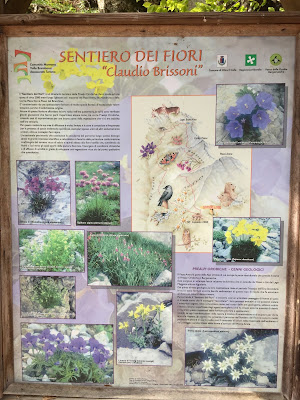

Two sign boards talking about "Il sentiero dei fiori" - flower walk.
